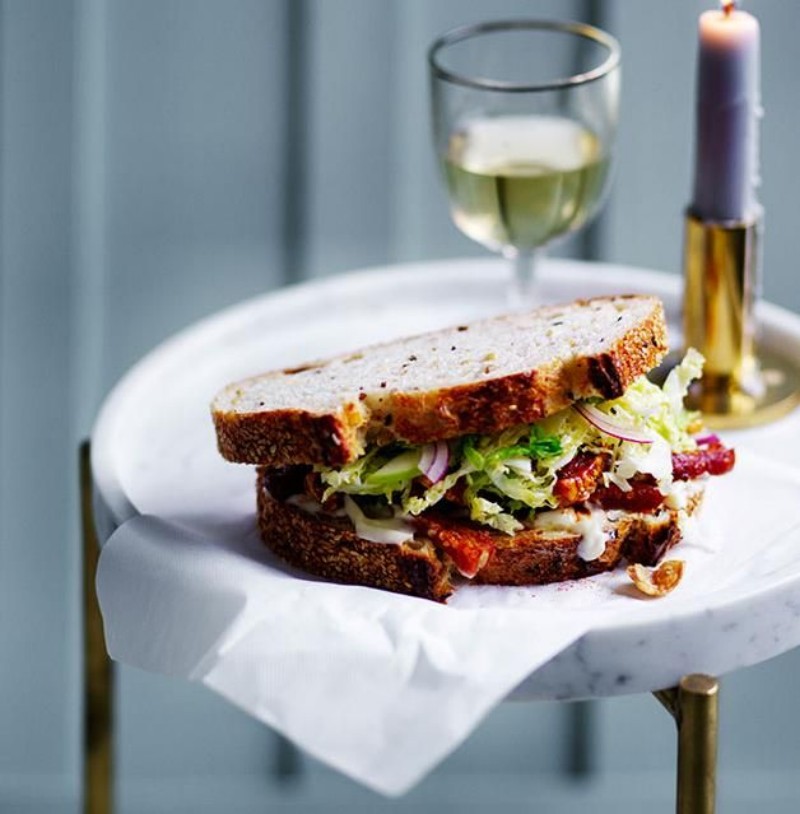Address
304 North Cardinal
St. Dorchester Center, MA 02124
Work Hours
Monday to Friday: 7AM - 7PM
Weekend: 10AM - 5PM
Address
304 North Cardinal
St. Dorchester Center, MA 02124
Work Hours
Monday to Friday: 7AM - 7PM
Weekend: 10AM - 5PM

In a world brimming with culinary delights, the sandwich stands out as a humble yet universally beloved food item. Its origins, a mere whisper of a story from a small town in England, have grown into a global sensation that transcends cultures and times. Join us on a journey to explore the sandwich’s fascinating history, its evolution from a gourmet delicacy to a grab-and-go favorite, and its enduring appeal that continues to captivate the hearts and taste buds of people around the world.
The sandwich, a simple yet beloved meal, has captured the hearts and stomachs of people around the globe. It’s a staple in lunchboxes, cafes, and even high-end restaurants, offering a versatile and satisfying meal option. This humble food item has a rich history, often associated with a small town in England, Sandwich.
In Sandwich, the town itself seems to carry the legacy of the sandwich. The town’s name has become synonymous with the food, much like the pizza in Naples or the curry in Leicester. It’s a charming place, with its cobbled streets, historic buildings, and a population that takes great pride in their sandwich’s fame.
The concept of the sandwich is simple: slices of bread with a filling in between. It’s this simplicity that has made it a hit across cultures. Whether it’s a classic ham and cheese, a gourmet turkey and avocado, or a spicy tuna roll, the sandwich can be tailored to suit any taste.
While the sandwich has become a global phenomenon, its origins are steeped in English history. The story goes that the sandwich was invented by John Montagu, the Fourth Earl of Sandwich, in the 18th century. Legend has it that he was so engrossed in playing cards that he requested his servant to bring him a meal without interrupting his game. Thus, the sandwich was born, a meal that could be eaten without the need to put down his cards.
The idea of a portable meal was revolutionary at the time, and the sandwich quickly gained popularity among the upper classes. It was the perfect companion for the busy lifestyle of the elite, who needed a quick and convenient snack.
Today, the sandwich is more than just a meal; it’s a cultural icon. It’s a symbol of convenience, diversity, and the joy of eating. From the humble street food vendor to the gourmet chef, the sandwich has proven to be a timeless favorite. It’s a testament to how a simple idea can evolve into a global phenomenon, all thanks to a little town in England and the busy card player who started it all.

Sandwich, the town that lends its name to the famous food item, is a picturesque place with a rich tapestry of history. Nestled in Kent, England, it’s a place where the past feels very much alive. The town’s narrow streets are lined with quaint shops and traditional pubs, each a testament to its storied past.
The Sandwich Castle, perched on a hill overlooking the town, is a highlight. This medieval fortress, dating back to the 11th century, offers a glimpse into the town’s military history. It’s a stark reminder of the town’s strategic importance in centuries past.
In the heart of Sandwich, you’ll find the historic St. Mary’s Church, a stunning example of Norman architecture. The church has stood the test of time, witnessing countless events and the coming and going of generations.
Sandwich is also known for its impressive collection of almshouses, built in the 14th century to provide housing for the elderly and poor. These almshouses are beautifully maintained and contribute to the town’s charm.
The Sandwich Heritage Museum, housed in the Old Town Hall, offers a fascinating look into the town’s history, from its founding by the Normans to its growth as a bustling port. It’s a place where visitors can learn about the sandwich’s possible origins and the town’s role in the development of the famous food.
As you wander through Sandwich, you’ll notice the unique blend of architectural styles, from Tudor to Victorian, each contributing to the town’s distinct character. The juxtaposition of old and new is a constant reminder of the town’s dynamic history.
The local people of Sandwich take great pride in their town’s history. They are happy to share stories and anecdotes about the place they call home, ensuring that the tale of the sandwich remains an integral part of the town’s identity.

John Montagu, the Fourth Earl of Sandwich, was a man of many interests and titles, but it was his association with the sandwich that would forever link his name to this beloved food. Born in 1718, Montagu was not only a nobleman but also a patron of the arts and a prominent figure in politics.
Montagu’s life was marked by his military service, which took him to various European theaters. It was during these travels that his fondness for gambling became well-known. His love for cards was so intense that he often preferred to eat while playing, leading to the creation of the sandwich.
The story of the sandwich’s invention is often told through the lens of Montagu’s card-playing habits. It’s said that he was so engrossed in a game that he requested his servant to bring him a meal that wouldn’t require him to put down his cards. Thus, the sandwich was born, a meal that could be eaten with one hand, allowing him to continue his gaming without interruption.
Despite his reputation for extravagance and debauchery, Montagu was also a patron of the arts and sciences. He was a member of the Royal Society, an organization dedicated to the advancement of scientific knowledge. His interests were diverse, and he was known to have a keen mind and a generous spirit.
Montagu’s personal life was as colorful as his public one. He was married three times, fathering numerous children, and his relationships were often the subject of scandal and speculation. Yet, through it all, the sandwich remained a silent testament to his practicality and innovation.
As the Fourth Earl of Sandwich, Montagu held several important positions in the British government, including serving as First Lord of the Admiralty. His influence extended beyond his personal interests, shaping the course of British history in significant ways.
Today, the Fourth Earl of Sandwich is remembered not just for his political and social contributions, but for the culinary innovation that bears his name. The sandwich, with its simple yet versatile nature, has become a symbol of convenience and a beloved staple in kitchens and cafes worldwide.

In the 18th century, amidst the hustle and bustle of London society, a meal was born that would soon transcend time and place. It was a time when the elite were on the move, seeking convenience in their meals.
The tale of the sandwich’s creation is one of necessity and practicality. It all started with John Montagu, the Fourth Earl of Sandwich, who was said to be deeply engaged in playing cards. He was so absorbed in his game that he needed a meal that would allow him to continue without interruption.
The servant brought the meal, but instead of a full plate, it was placed between two slices of bread. This allowed Montagu to eat one-handed, freeing his other hand to keep playing cards. The concept was simple yet revolutionary, and it quickly caught on among the aristocracy.
As the story spread, the sandwich became a symbol of elegance and convenience. It was perfect for those who were always on the go, whether it was a politician, a soldier, or a busy businessperson. The sandwich was born as a quick, portable meal that could be enjoyed anywhere.
Over time, the sandwich evolved. Chefs began to experiment with different fillings, creating a variety of flavors and textures. It became a canvas for culinary creativity, with people all over the world adding their own twists to the basic concept.
Today, the sandwich is a global phenomenon. It’s a simple meal that has become a symbol of comfort and familiarity. Whether it’s a classic ham and cheese or a gourmet creation, the sandwich has proven to be a timeless and adaptable food that continues to delight people of all ages and backgrounds.

The sandwich, once a simple meal for a card-playing aristocrat, has transformed over the centuries from a gourmet delicacy to a quick grab-and-go snack. In its early days, the sandwich was a symbol of status and convenience for the wealthy.
As the 19th century rolled in, the sandwich began to evolve. Gourmet chefs started to elevate the humble sandwich, filling it with exotic ingredients and creating elaborate combinations that were often served as part of a multi-course meal.
The rise of the sandwich as a gourmet item was furthered by the development of sandwich shops and cafes. These establishments offered a variety of sandwiches, from the classic BLT to more adventurous creations, catering to a growing demand for sophisticated food on the go.
With the advent of the 20th century, the sandwich took on a new role. The fast-paced lifestyle of urban dwellers led to the creation of simpler, more portable sandwiches. These “to-go” sandwiches were perfect for busy commuters and office workers, who appreciated the convenience of a quick bite.
The 21st century has seen the sandwich become even more diverse. From the artisanal offerings of high-end restaurants to the mass-produced sandwiches found in convenience stores, the sandwich has become a staple in every corner of the globe. It’s now a food that can be tailored to any taste, from vegan and gluten-free to spicy and smoky.
Today, the sandwich is not just a meal; it’s an experience. It’s a reflection of the times, adapting to the changing needs and preferences of consumers. Whether it’s a gourmet creation or a simple lunchbox sandwich, the sandwich continues to evolve, offering a little something for everyone.

The Sandwich Festival, a delightful event held in the town that shares its name with the famous food, is a celebration of all things sandwich-related. The festival brings together locals and visitors alike, creating a lively atmosphere filled with food, fun, and festivities.
Year after year, the streets of Sandwich come alive with the aroma of freshly made sandwiches. From traditional ham and cheese to creative and exotic fillings, the festival showcases the versatility of the sandwich.
One of the highlights of the festival is the Sandwich Sandwich competition, where chefs and sandwich enthusiasts compete to create the most unique and delicious sandwich. The creativity on display is inspiring, with entries ranging from classic to contemporary.
Children and families find joy in the many activities planned for them, including sandcastle building competitions, face painting, and games. The festival is a great opportunity for everyone to enjoy a day out, no matter their age.
Local businesses and food vendors take part in the festivities, offering a variety of sandwiches, drinks, and other treats. It’s a chance for visitors to sample the best of what Sandwich has to offer, both in terms of food and atmosphere.
The festival also serves as a platform for local artisans and crafters to showcase their work. Visitors can browse a range of handmade goods, from jewelry and clothing to homemade crafts.
As the day winds down, the Sandwich Festival culminates in a grand fireworks display, lighting up the night sky and bringing a sense of excitement and closure to the event. It’s a memorable end to a day filled with delicious sandwiches and good company.
The Sandwich Festival is more than just a celebration of food; it’s a celebration of community and heritage. It’s a day when the town of Sandwich comes together to honor the legacy of the sandwich and the joy it brings to people worldwide.

In the fast-paced world we live in, the sandwich remains a staple, embodying the essence of convenience. It’s a meal that can be eaten on the go, fitting perfectly into a busy lifestyle.
The sandwich’s adaptability is one of its greatest strengths. It can be found in countless variations, from the classic ham and cheese to the trendy avocado toast, each offering a different taste experience.
Comfort food at its finest, the sandwich is often associated with home and nostalgia. Whether it’s a childhood favorite or a comforting meal after a long day, the sandwich holds a special place in many hearts.
The simplicity of the sandwich also makes it a favorite among health-conscious individuals. With the rise of clean eating, sandwiches have been reimagined with fresh, whole foods, providing a balanced meal in a convenient package.
In the culinary world, the sandwich has become a canvas for creativity. Chefs and food enthusiasts are constantly experimenting with new flavors, textures, and ingredients, pushing the boundaries of what a sandwich can be.
Beyond the kitchen, the sandwich has become a symbol of community and connection. It’s a food that brings people together, from casual picnics to formal gatherings, uniting us over a shared love of food.
As we continue to evolve, the sandwich remains a timeless staple. It’s a meal that speaks to the heart of what we seek in food: simplicity, comfort, and a touch of convenience that fits seamlessly into our lives.

The sandwich, born in England, has spread across the globe, becoming a beloved staple in cultures far and wide. In Japan, the bento box is a nod to the sandwich’s influence, offering a portable meal with various fillings and compartments.
In the United States, the sandwich has evolved into a culinary art form, with cities like New York famous for their unique and diverse sandwich offerings. The deli sandwich is a national institution, with a variety of styles and flavors.
In Italy, the panini has taken the sandwich to a whole new level, with its crispy outside and melt-in-your-mouth interior, often grilled with a variety of fillings.
In the Middle East, the shawarma sandwich, with its flavorful meats and freshly baked pita, is a street food favorite that captures the essence of the sandwich’s adaptability.
In South America, the arepa, a cornmeal-based bread, often serves as the canvas for a variety of fillings, showcasing the sandwich’s ability to blend with local flavors.
Even in the smallest villages and most remote corners of the world, you’ll find a version of the sandwich, tailored to the local palate. Whether it’s a humble filling of cheese and onions or a lavish spread of smoked salmon and caviar, the sandwich has become a universal language of food.
The global impact of the sandwich is not just about the food itself; it’s about the connection it fosters. It’s a reminder that, despite our differences, there are shared experiences and tastes that bring us together.

Is the sandwich really named after the town of Sandwich, England?Yes, the town of Sandwich, England, is believed to be the birthplace of the sandwich, named after John Montagu, the Fourth Earl of Sandwich, who was said to have asked for his meal to be served between two slices of bread so he could eat it while playing cards.
Who is credited with inventing the sandwich?The sandwich is commonly attributed to John Montagu, the Fourth Earl of Sandwich, who is said to have requested his servant to bring him a meal that he could eat without interrupting his card game.
Is there any historical evidence to support the sandwich’s invention story?While the story of the Earl of Sandwich eating a sandwich while playing cards is widely told, there is no definitive historical evidence to confirm this. However, it is a popular narrative that has been perpetuated through the years.
Why is the sandwich so popular around the world?The sandwich’s popularity is due to its simplicity, convenience, and adaptability. It can be made with a wide variety of ingredients and is easily transportable, making it a perfect meal for people on the go.
Are there different types of sandwiches?Absolutely, there are countless types of sandwiches, from the classic ham and cheese to gourmet options like the BLT, submarine, and panini. Each region and culture has its own unique variations.
Can you name some famous sandwich shops?Famous sandwich shops around the world include Katz’s Delicatessen in New York City, which is known for its pastrami sandwiches, and Pret A Manger, a popular chain in the UK and the US for its freshly made sandwiches and salads.

The sandwich, a simple yet enduring creation, has woven itself into the fabric of our daily lives. Its appeal lies in its ability to evolve with the times, adapting to new tastes and preferences.
Despite its humble beginnings, the sandwich has transcended its origins, becoming a symbol of comfort and convenience. It’s a meal that knows no borders, enjoyed by people from all walks of life.
The sandwich’s versatility is unmatched, offering a canvas for creativity and a canvas for sustenance. From the most basic of fillings to the most gourmet combinations, it speaks to the diversity of our culinary world.
In a world that moves at a rapid pace, the sandwich remains a steadfast companion, providing a moment of pause and satisfaction. It’s a reminder that sometimes, the simplest things can bring the most joy.
As we continue to explore new flavors and combinations, the sandwich’s timeless appeal remains a constant. It’s a testament to the enduring power of a good meal, shared with friends and family, or enjoyed alone on a quiet day.